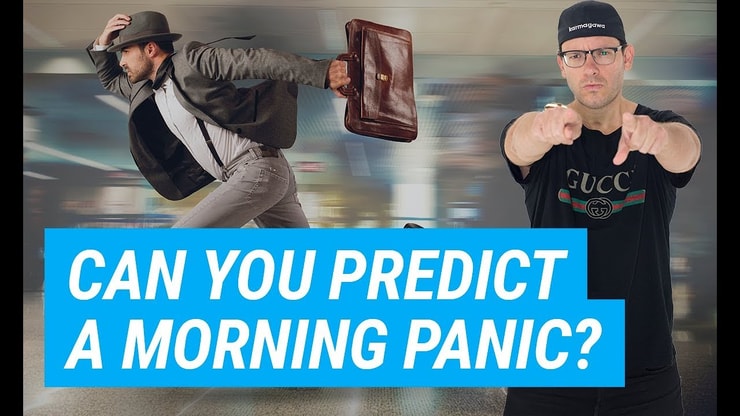New traders ask me this a lot: “what are the top trading strategies for a small account?”
Let me say this first: So many traders assume you need a big account to start trading. That’s not true.
In fact, I think it’s smart to trade with a small account if you’re new to the markets.
Before you grow your account, you’ve gotta focus on learning. Don’t swing for the fences as a beginner … start by learning how to take singles.
This year, I passed $6 million in profits.* And every year, I reset my account to trade small along with my students. It’s how I teach the process using a handful of strategies.
Fact: most traders lose money. They don’t know how to take a small account and grow it. I won’t lie to you … the process can be an uphill battle. It’ll take a TON of discipline and lots of studying.
But with effort, it can be done.
Are you ready to commit? Let’s take a look at how to grow a small account…
(*Please note: My results, along with the results of my top students, are far from typical. Individual results will vary. Most traders lose money. My top students and I have the benefit of many years of hard work and dedication. Trading is inherently risky. Do your due diligence and never risk more than you can afford to lose.)
Table of Contents
- 1 Can I Trade With Little Money?
- 2 Benefits of Trading With a Small Account
- 3 How Do I Create a Trading Account?
- 4 5 Top Trading Strategies for a Small Account
- 5 Apply to the Trading Challenge
- 6 Can I Grow a Small Trading Account Into a Large One?
- 7 How Do You Grow a Small Trading Account Successfully?
- 8 The Process
- 9 Conclusion
Can I Trade With Little Money?
Yes, you can trade with little money. Using a small account can be a great way to learn. So can paper trading.
Several brokers lowered their deposit requirements in 2020. Some even got rid of them. This is great for small accounts! It means you have more options … So do your research and choose a broker that fits you.
Brokers have also been racing to commission-free trading. Lower commissions are good. Just make sure you’re not using a low-quality broker to save a few bucks. You get what you pay for.
Growing a small account could be tricky if you focus on pricey stocks like Tesla (NASDAQ: TSLA). You’re probably better off looking for OTC stocks that can make big moves. And you can usually get more shares because they’re cheaper…
But you gotta know what you’re doing with these sketchy stocks. Start with my FREE online guide here.
Benefits of Trading With a Small Account
If you wanted to learn how to golf, would you immediately try for the PGA Tour? No. You’d join a smaller league to practice. Choosing your account size is pretty similar.
Small accounts will have to deal with the pattern day trader (PDT) rule. Accounts under $25,000 are only allowed three day trades — buying and selling a stock on the same day — per five business days.
Maybe that isn’t what you wanna hear. But I think it’s necessary.
The PDT rule can help prevent traders with small accounts from overtrading. It encourages traders to narrow their trades and only play quality patterns.
Another benefit of using a small account? Order fills.
Small accounts can have an easier time entering and exiting a position. There’s a better chance of getting filled at the price you want.
Big positions can have a hard time getting filled at a specific price. If they take out the bidders while selling, the price can drop and fill the order lower. This is called slippage.
Look at a small account as a learning opportunity. If you take advantage of it, you’ll be more prepared to grow.
How Do I Create a Trading Account?
Creating a trading account is pretty simple. But you’ll need to choose the right broker. Before you choose, consider questions like:
- Do you like the software?
- Do you want to go long, short, or both?
- Will you only trade listed stocks? Or will you trade OTC stocks as well?
Certain brokers may help your progress, while others might hold you back. Find one that’s tailored to your style.
Creating an account won’t take long. With most brokers, you can wire money from your bank in just a few days.
But don’t just start blindly buying stocks. Start building your own trading strategy — in just 30 days. My 30-Day Bootcamp is designed to take you from rookie to pro trader level knowledge for a ridiculously low price. Start today!
Now let’s get into some trading strategies…
5 Top Trading Strategies for a Small Account
One Percent Risk Rule
If you’re trading with a small account, you gotta manage how much money you risk.
If you risk 1% of your account on each trade, you have 100 chances before you lose your money. That can be a good format for small accounts.
For example, if you’re under PDT, it’ll take about 33 weeks to make 100 trades. As long as you study and review your mistakes, you can learn a lot in that time.
When you learn to spot the right setups, it’s possible to make as much as 50% in profits. With volatile penny stocks, sometimes you can see a stock gain 300% in a single day! But you won’t get there by chasing stocks with no plan.
Always remember to manage your risk. And always stick to your trading plan.
First Green Day
A first green day isn’t just a trading strategy — it’s also a pattern. You may see this setup more than once over time.
What is it? This is what you should look for…
Start by finding a stock that’s had a good run … preferably several days of gains.
There’s usually a sell-off after a stock’s had a run. Buyers think the run is over, and they’re looking to exit.
So the stock will usually pull back — that’s a red day. You want to see at least one red day, and preferably a few.
Sometimes a stock will find a support level after the sell-off. Once the major selling stops, short sellers may get nervous. When they cover their positions, it can cause a short squeeze.
A first green day is just what it sounds like: the first day a stock goes green after a sell-off. These stocks have the most potential when there’s low selling, more buying, and shorts covering.
Education can prepare you to spot these. Look for good examples of a first green day and study them!
More Breaking News
- BULL Anticipates Strong FY Earnings Amid Strategic Moves
- WULF Stock Surge: Should You Jump In?
- Sandstorm Gold’s Latest Moves: Time to Jump In?
Breakout
A breakout is one of the more popular trading strategies for a small account. Like a first green day, it’s a pattern.
It can happen in more than one way. Some occur in one day — and some can take years to develop.
So what’s a breakout? Here’s how they happen…
After a stock runs, the price usually comes down. But people can still be stuck in the stock at high prices. Those prices become a resistance point. You gotta get through them.
You might see the stock consolidate at way lower levels. This is normal. After the stock consolidates, it can start to make gains again.
Some stocks may get close to their previous highs. With enough volume, they can break out of those resistance points and go even higher.
Like I said, it can happen in different ways. Some breakouts can be more important than others.
A popular stock that’s testing a price from years back could get a lot of attention. Long periods of consolidation can potentially make a breakout work better. A random stock that hasn’t consolidated for very long can be less likely to have a big breakout.
Panic Dip Buy
This is one of my favorite penny stock patterns. I’ve been trading this one for years. It often happens in the morning.
If you’re learning how to grow a small account, watch for these.
Here’s how to spot a panic dip buy…
Look for a stock that’s risen a lot over several days or weeks. When it moves into a sell-off, shareholders have to think fast. Sometimes they panic and sell.
If there’s enough selling, it can cause a snowball effect. Look for at least a 20%–30% drop. But generally, the bigger the better. You want to see the price dive in a short amount of time — ideally a few minutes.
This makes buyers see it as a discount. Look out for them to start piling in. Using Level 2 quotes can help you find this area. Some traders call this shift in the price action “the turn.”
With enough rapid selling and buying, the stock can bounce quickly. Sometimes, it can even bounce higher than before the sell-off!
But don’t go buying any stock that dips. Some stocks crash for a good reason. Especially in the land of sketchy penny stocks.
You want to see all these indicators align. Buyers must see the panic as a discount, not a dying stock.
Try to get in close to the bottom, and always manage your risk.
Cutting Losses Quickly
This is my #1 rule. To me, it’s the most important part of day trading. This isn’t a pattern — it’s a way of life.
Never hold onto a losing trade. The hold-and-hope mentality can be a disaster.
Traders can be very stubborn when it comes to cutting losses. But remember … it’s better to lose a little than a lot. Even if you’re wrong, you can buy again and potentially profit.
If you trade long enough, this rule will likely save your butt more than once. Some traders struggle to learn this … but it’s crucial if you want to become self-sufficient.
Learn how you can cut losses quickly in any market. Get the “Volatility Survival Guide” now for no cost and prepare for any wild market.
Apply to the Trading Challenge

2025 Millionaire Media, LLCIf you’re committed to learning, check out my Trading Challenge. I started the Challenge to become a mentor and teach students how to trade penny stock patterns.
If you’re looking for hot stock picks, it’s not for you. But if you’re a hard worker and want to learn strategies that can help you become a self-sufficient trader, consider applying.
If you’re accepted, you’ll have access to so much learning material that can help you learn how to grow a small account. There’s a TON of video lessons, webinars, and more.
You’ll also be able to join our amazing Challenge chat room. It’s your opportunity to network with traders who all have the same goal: becoming self-sufficient.
I’m proud to be transparent in an industry of fakes. I post all my trades on Profit.ly. By studying my mistakes, you can learn to avoid making them yourself.
I’ve been trading for 20 years and teaching for over 10. I now have several six- and seven-figure students who all became self-sufficient by using these trading strategies. * Many of them started with small accounts!
If you have the dedication, the Challenge can help you learn how to grow a small account.
Apply today and start your journey!
Can I Grow a Small Trading Account Into a Large One?
If you put your education first, you can learn how to grow a small account.
Focus on having the right mindset. Stick with setups that work for you. You want the odds to be in your favor, so make sure to keep an eye on risk/reward.
If you’re constantly risking $100 to make $50, that’s not a good risk/reward. Focus on how you can improve your odds with better setups for how you trade.
Don’t chase a stock that’s up a lot. That’s what losers do. Create a solid trading plan and stick to it.
Breaking rules isn’t a good trading strategy for growing a small account. Don’t put yourself in a losing situation.
How Do You Grow a Small Trading Account Successfully?
The Process
As you learn how to grow a small account, create a reliable process. It’s your guide … a blueprint for becoming self-sufficient. You’ve gotta stick to it.
Breaking your own rules can slow the process. Think the best traders make a habit of breaking rules? Hell no. They work tirelessly to improve.
Develop good habits early on. Get in the right mindset. This can help you stick to your process.
Risk Management
I’ll never stop harping on this. If you don’t respect your risk level, you might as well be gambling.
Cut. Losses. Quickly.
There’s a reason it’s rule #1. You will lose from time to time. Every trader does. But this principle can help keep you in the game.
Conclusion
If you work hard enough, you can grow a small account. I’ve done it, and so have some of my top students.* Your journey can go a few different ways … You can slack off, or you can be aggressive and pay attention to what you’re learning.
Use these trading strategies for small accounts. They’ve been around for a long time. You can learn what to look for. Whether it’s a pattern or a rule, these strategies can be helpful.
Study them. Have a trading plan. Track every trade and learn from them all.

This can be a tough journey. But if you keep studying, you can have a better chance of becoming self-sufficient.
Knowing what to watch can also be a big help … Sign up now to get my weekly watchlist.
Do you understand these trading strategies? Let me know in the comments!








Leave a reply